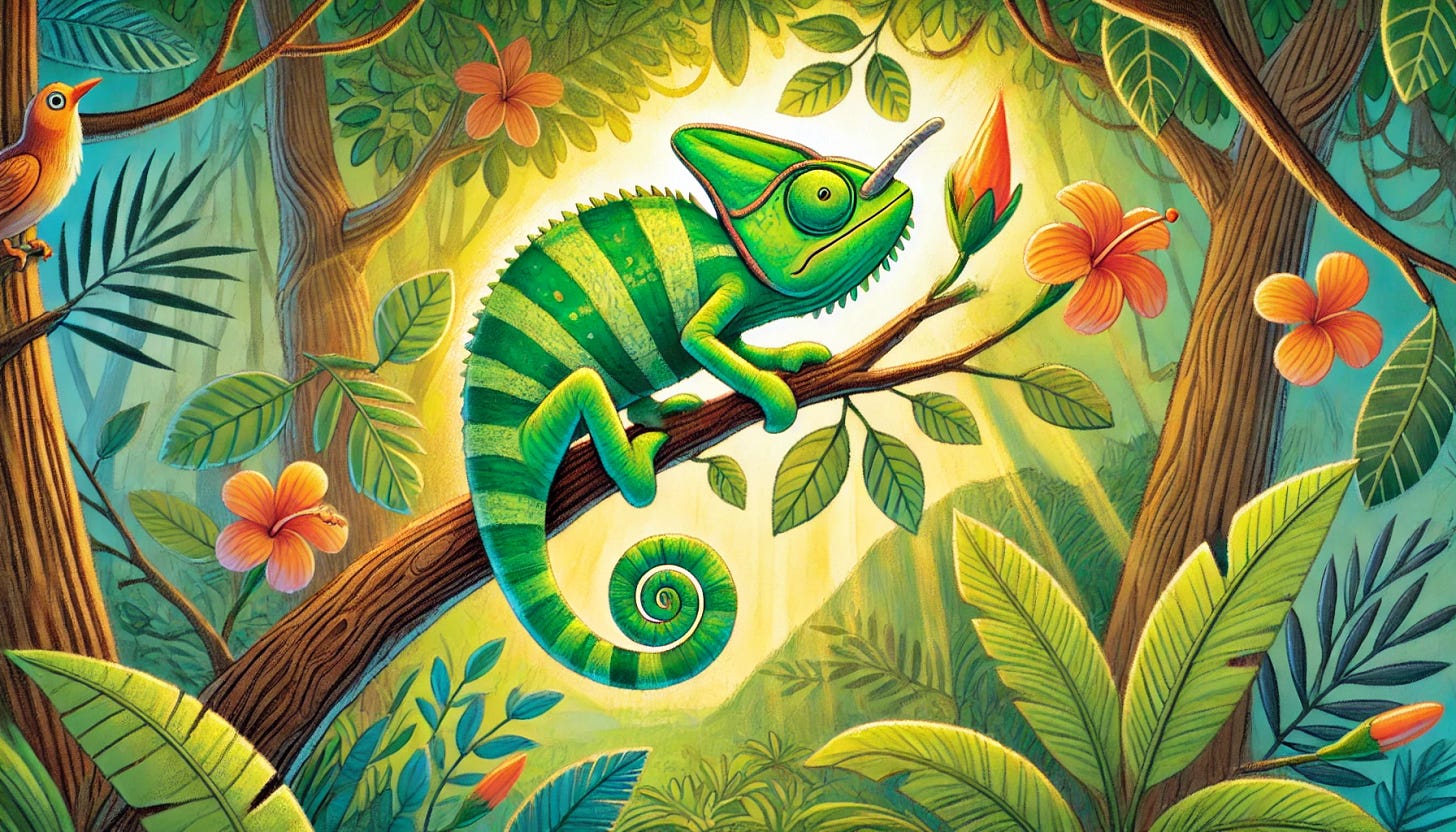Why Do Chameleons Change Color?
One moment, a chameleon might be green, and the next, it could turn yellow, red, or even blue! But why do they do this? Do they change color to hide? Do they do it when they feel happy or scared? Let’s explore the magical world of chameleons and discover the secret behind their color-changing superpower!
Hello my friends!
For a quick note, welcome to Tidbits with Titus, a podcast and newsletter where we tackle the big, curious questions kids ask every day in fun, bite-sized ways! I’m Alexander Titus, but I go by Titus. I’m a scientist, adventurer, and a huge fan of making science, technology, and life accessible to all ages. From “How does electricity work?” to “What are taxes?” and even “Why is the sky blue?” I’m here to dive into these wonder-filled questions with engaging stories and simple explanations that spark curiosity and make learning a joy. This effort is all about creating a space where families can learn together, discover the magic of the every day, and find thoughtful ways to explore the world’s big mysteries. Let’s make curiosity a family tradition—one tidbit at a time!
Just so you know, these podcast episodes are all AI-generated using Google’s really cool NotebookLM technology. That means there are some errors in how words are said, but that is part of the fun!
If your little ones have questions that you want help answering, shoot me an email at questions@tidbitswithtitus.com and I’ll see what I can do!
You can subscribe to the newsletter that has this information as well at tidbitswithtitus.com.
Also please share with anyone you think would be interested. The more the merrier!
Cheers,
-Titus
Meet the Chameleon!
Chameleons are special reptiles that live in warm places like Africa, Madagascar, and parts of Asia. There are over 200 different kinds of chameleons in the world! They come in all sizes—some are as small as your finger, while others can grow as long as a ruler!
Chameleons are masters of disguise with their color-changing skills, but they also have other cool features:
Big eyes that move separately – Chameleons can look in two different directions at the same time!
A long, sticky tongue – Their tongues shoot out super fast to catch insects for food.
Curled tails – They use their tails to help them balance on branches.
Strong, gripping feet – Their feet are perfect for climbing trees and holding onto branches.
But their most famous trick is their ability to change color. How do they do it? Let’s find out!
How Do Chameleons Change Color?
Many people think chameleons change color by mixing colors inside their skin, like paint. But that’s not quite how it works!
Under their skin, chameleons have special layers of tiny cells called iridophores. These cells contain tiny crystals that reflect light. When a chameleon changes color, it moves these crystals around to reflect different kinds of light!
Here’s how it works:
When a chameleon is relaxed, the crystals are packed close together, and they reflect blue and green light, making the chameleon look green.
When a chameleon gets excited, the crystals spread out and reflect yellow, orange, or red light, changing the chameleon’s color!
It’s like having a rainbow trapped inside their skin, and they can control which colors show!
Why Do Chameleons Change Color?
Now that we know how chameleons change color, let’s talk about why they do it. There are a few reasons chameleons use their amazing ability:
1. To Communicate With Other Chameleons
Chameleons don’t talk like humans, but they can send messages to each other using colors!
Bright colors (like red, orange, or yellow) mean a chameleon is excited or feeling strong. Males use bright colors to show they are ready to fight or find a mate.
Darker colors (like brown or black) mean the chameleon is scared or upset. This can be a warning to other chameleons to stay away!
Soft colors (like light green or blue) mean the chameleon is calm and relaxed.
Chameleons use their colors like a secret mood ring to show how they feel!
2. To Control Their Body Temperature
Chameleons are cold-blooded, which means they can’t make their own body heat like humans do. Instead, they change color to help warm up or cool down!
When they are cold, they turn darker (black or dark brown) to absorb more heat from the sun.
When they are hot, they turn lighter (yellow or white) to reflect the sun and stay cool.
It’s like wearing a black shirt on a sunny day—it makes you feel warm! But wearing a white shirt keeps you cooler. Chameleons change their colors to stay comfortable in different temperatures.
3. To Blend Into Their Environment?
Many people think chameleons change color to hide from predators, like birds or snakes. But that’s not really their main reason!
Most chameleons already match their surroundings because their natural color is green or brown. This helps them stay hidden in trees. They don’t need to turn crazy colors like pink or blue just to hide!
So while some chameleons might use color to blend in, it’s not the main reason they change colors. They mostly do it for communication and temperature control!
Fun Chameleon Facts!
Want to know some more cool things about chameleons? Here are a few fun facts:
✅ They have super eyesight! – Chameleons can see in almost every direction at once, helping them spot bugs and predators.
✅ Their tongues are super fast! – A chameleon’s tongue can shoot out and catch an insect in less than a second—that’s faster than you can blink!
✅ They are really slow movers. – Unlike other lizards, chameleons don’t run fast. They move in a slow, rocking motion to look like leaves blowing in the wind.
✅ Baby chameleons are born ready to go! – Some chameleons hatch from eggs, while others are born alive, but they can all change color right away!
Can Other Animals Change Color?
Chameleons aren’t the only animals with color-changing superpowers! Other cool creatures can change color too:
🦑 Octopuses & Squids – These sea creatures can camouflage themselves instantly to hide from predators.
🐟 Cuttlefish – They can change colors and patterns on their skin to talk to other cuttlefish!
🦎 Anoles & Geckos – Some other lizards, like anoles, can also change color—but not as well as chameleons!
Even though these animals have different ways of changing color, they all use it to survive in the wild!
Try This Fun Chameleon Activity!
Want to see how light changes colors just like a chameleon’s skin? Try this easy experiment at home!
What You’ll Need:
🔵 A flashlight
🔵 A CD or DVD (the shiny kind)
🔵 A dark room
What To Do:
1️⃣ Go into a dark room and shine the flashlight onto the shiny side of the CD.
2️⃣ Move the light around and watch rainbow colors appear!
3️⃣ The CD reflects light just like a chameleon’s skin—different angles show different colors!
This is similar to how chameleon crystals reflect light to create different colors!
The Amazing World of Chameleons
Chameleons are some of the coolest animals on Earth! They don’t change color to hide, but they do it to communicate, control their body temperature, and show their mood. Their skin has tiny special crystals that move around to reflect different colors.
Next time you see a chameleon, remember—it's not just trying to disappear! It might be talking, warming up, or just showing off its amazing colors!
Would you like to have a color-changing superpower like a chameleon? 🦎✨














Share this post